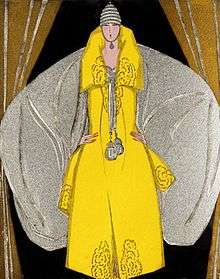Fashion merchandising

Fashion merchandising involves the production of fashion designs and distribution of final products to the end consumer. Fashion merchandisers work with designers to ensure that designs will be affordable and desired by the target market.[1] Fashion merchandising involves apparel, accessories, beauty, and housewares.[2] The end goal of fashion merchandising in any of these departments is to earn a profit.[3] Fashion merchandisers' decisions can considerably impact the success of the manufacturer, designer, or retailer for which they work.
Background

During ancient times, individuals shopped in markets for goods. The ancients were attracted to rare fashions that brought variation and excitement into their lives. These markets have transformed into today's department, specialty, and discount retailers. For many years, business people in the fashion industry were convinced that they could persuade consumers to desire their particular products. Fashion executives had no interest in the needs and wants of consumers. However, fashion personnel realized that they would have to adapt fashion items to the demands of consumers. At the beginning of the twenty-first century, understanding traits, motives, and desires of target markets became an essential method to fashion entrepreneurial success.[3]
Rights of merchandising
Fashion merchandisers follow the five rights of merchandising, or 5Rs, to ensure that they properly meet the needs of consumers; thus, turning a profit.[3]
The five rights of merchandising include:
- the right merchandise
- at the right price
- at the right time
- in the right place
- in the right quantities.[3]
By researching and answering the five rights of merchandising, fashion merchandisers can gain an understanding of what products consumers want, when and where they wish to make purchases, and what prices will have the highest demand. Both fashion retailers and manufacturers utilize the 5Rs.[3]
Manufacturers

Clothing manufacturers practice fashion merchandising differently than retailers. Manufacturer merchandisers forecast consumers' preferences for silhouettes, sizes, colors, quantities, and costs each season. When making decisions, manufacturer merchandisers must keep retailers and end consumers in mind. Following the forecasting stage, manufacturer merchandisers meet with designers to develop products that consumers will purchase most. By referring to the five rights of merchandising, manufacturer merchandisers determine the best fabric, notions, product methods, and promotions for products.[3] These decisions all contribute to final retail costs, which must be affordable to end consumers.
Retailers

In comparison to manufacturer merchandisers, retailer merchandisers also begin their process by forecasting industry and fashion trends with their target markets in mind. Sales are predicted in retail dollars and beginning of the month (BOM) stock. Similar to manufacturer merchandisers, retailer merchandisers must make all decisions regarding the final consumer. Decisions are made based on the past, present, and future of the economy, sales, industry and fashion trends, region and world events, and the fashion cycle. When selecting merchandise to offer, retailer merchandisers will consider their target markets' color, style, size, and cost preferences. Once accurate decisions are made, retailer merchandisers will order goods from vendors or produce private labels.[3] Following shipment, ordered seasonal apparel assortments are strategically arranged on sales floors, or visually merchandised.
Education
Individuals interested in building a career in fashion merchandising should earn an associate's or bachelor's degree in fashion merchandising or a related field, such as marketing. Relevant courses include, but are not limited to, fashion, accounting, marketing, advertising, management, and psychology. In addition to schooling, those aspiring to work as fashion merchandisers should gain retail work experience.[2][4]
Careers
Fashion merchandising careers are as follows:
- Buyer: Develop six-month buying plans and order assortments for each season. Travel to markets and trade shows to purchase the latest fashions for stores.[5]
- Account executive: The liaison between manufacturers and buyers. Handle several retail accounts, present manufactures' lines to buyers, and relay fashion and promotional information.[5]
- Store manager: Hiring, training, and overseeing employees as well as monitoring sales for a specific retail store.[5]
- Merchandise coordinator: Responsible for visual merchandising. A liaison between the manufacturer and retailer.[5]
- Showroom manager: Display fashion lines, present collections, and manage multiple retail accounts. Also, manage expenses and ensure profitability.[5]
- Merchandise planner: Assist a fashion company with meeting objectives through technologically and mathematically calculated solutions. Additionally, discover trends, develop financial plans, and determine merchandise reorders.[5]
References
- ↑ Rangel, Cynthia (April 28, 2011). "What Exactly is Fashion Merchandising Anyway?". IADT School of Design at Sanford-Brown College.
- 1 2 The College Board. "Fashion Merchandising College Degree Programs". bigfuture.collegeboard.org. Retrieved 2016-11-22.
- 1 2 3 4 5 6 7 Steele, Valerie; Stone, Elaine (2010). The Berg Companion to Fashion. Oxford: Bloomsbury Academic. pp. 296–297 – via Berg Fashion Library.
- ↑ "What Training Is Required for a Career in Fashion Merchandising?". Retrieved 2016-11-22.
- 1 2 3 4 5 6 Fashion Institute of Design & Merchandising. "Exciting Careers in Fashion Merchandising & Marketing Await!". fidm.edu. Retrieved 2016-11-22.